Art World
7 Movies Featuring Dastardly Art Dealers That Prove Gallerists Make the Best Hollywood Villains
Next time you're getting ready to fire up Netflix or Amazon Prime, check out these recommendations.
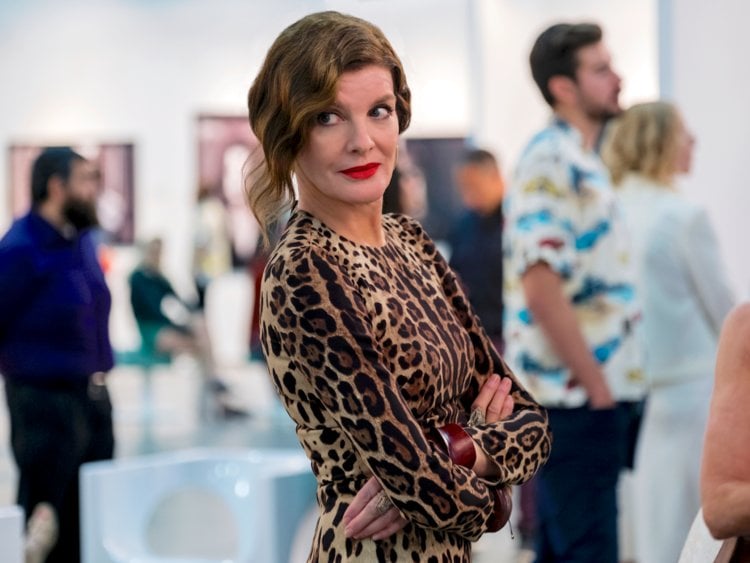
Next time you're getting ready to fire up Netflix or Amazon Prime, check out these recommendations.

by
Katie White

If you’ve ever watched a movie set in the the art world, you know what to expect: collectors traipsing about in cocktail attire and furs; artists being tortured by their genius; everyone speaking in vague but definitely pretentious accents; blunt bobs and oversize glasses in every direction; and art dealers—the ringleaders of this whole monied hoopla—as the inevitable villains.
The roles might not be such a stretch, what with the Mary Boones of the world, but do the movie studios ever get it right? You be the judge. Below are seven movies featuring villainous gallerists, dealers, and auction house specialists.
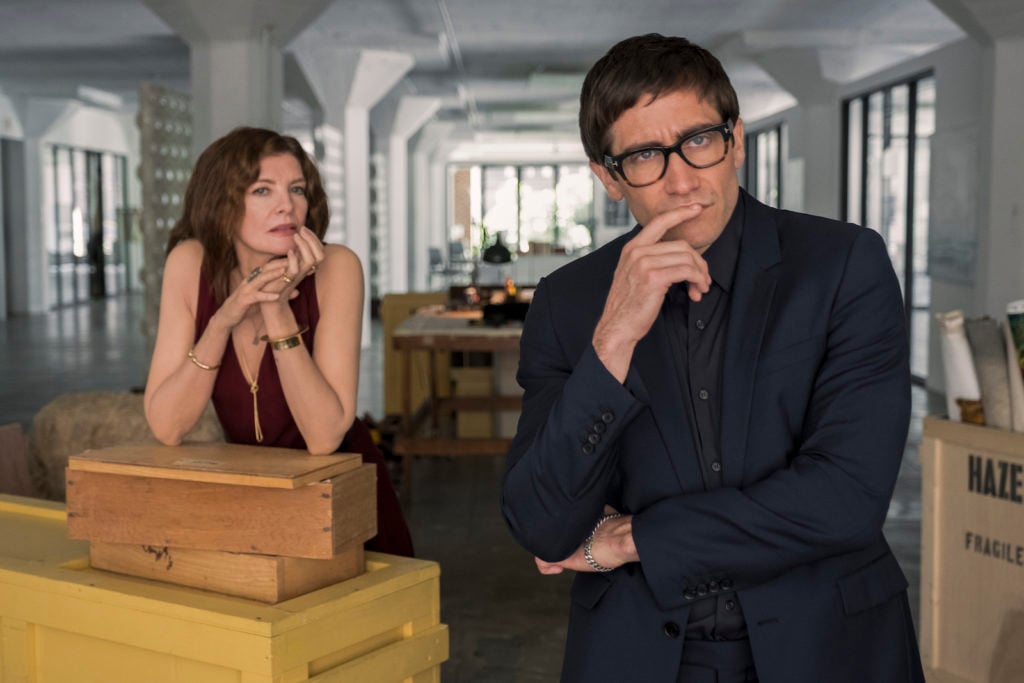
Rene Russo and Jake Gyllenhaal in Velvet Buzzsaw. Courtesy of Netflix.
In this supernatural thriller, Jake Gyllenhaal plays Morf Vandewalt, a $5-a-word art critic who can make or break careers with a single review (Gyllenhaal modeled the character after none other than Jerry Saltz). An ambitious gallery underling, Josephina (Zawe Ashton), discovers the artwork of her reclusive neighbor in the trash and brings it to Vandewalt, who is captivated by the expressive and even grotesque scenes of anguish.
The mentally ill (and possibly murderous) artist’s dying wish that the work be destroyed doesn’t deter the savvy but savage gallerist, Rhodora Haze (Rene Russo), nor the bluntly bobbed art advisor, Gretchen (Toni Collette), who are both all-too-eager to line their pockets with profits—until, that is, horror-flick appropriate vengeance is meted out upon each and every one of them.
What’s the art like?: Nightmarish in a Henry Darger-meets-Chaime Soutine kind of way.
Most memorable line: “Critique is so limiting and emotionally draining.”
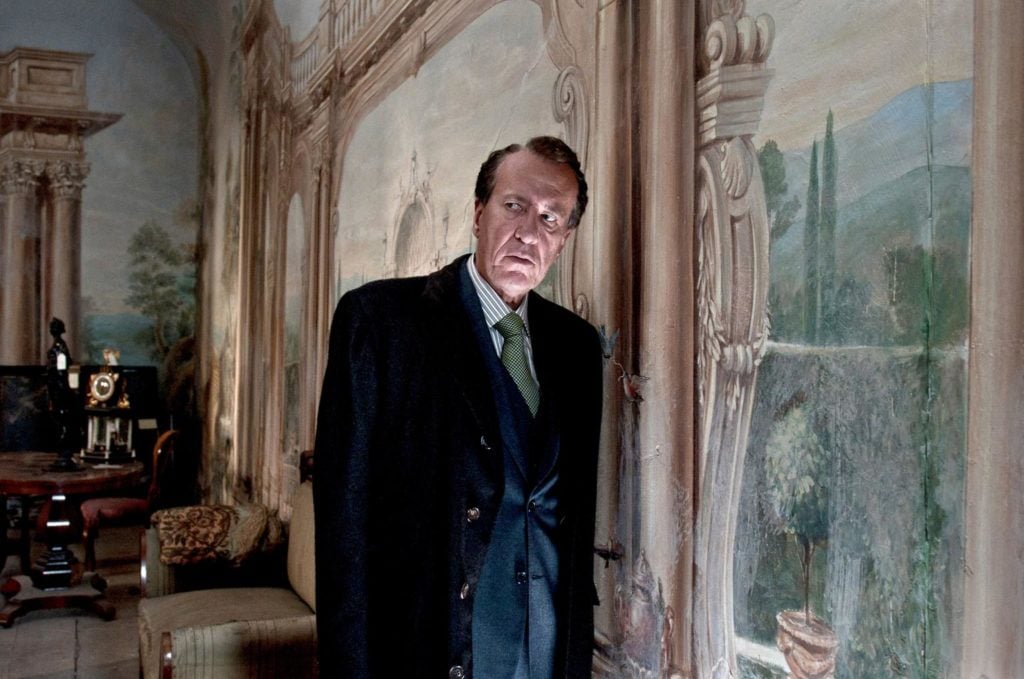
Geoffrey Rush as Virgil Oldman. Courtesy of Warner Bros.
Why limit the treachery to art dealers when auction houses specialists can be just as duplicitous? Enter Virgil Oldman (Geoffrey Rush), the highly regarded, but somewhat solitary director of an auction house who figures as both perpetrator and victim in this elaborate English-language Italian drama. In the movie, Oldman is hired by a reclusive young heiress, Claire Ibbetson (Sylvia Hoeks), to appraise and sell her inheritance of art and antiques. But like a good rich eccentric, she refuses to meet face-to-face, instead speaking to Oldman through a wall.
Over time, Oldman finds himself enamored by the mysterious woman, confiding his feelings to an artificer, Robert (Jim Sturgess), with whom he works. Which is all very nice, except Oldman is leading a double art-world life. When he’s not murmuring through estate walls, he is busy selling forgeries and mis-attributed work with the help of his friend and artist, Billy Whistler (Donald Sutherland). Romance, deception, conspiracy, and even mechanical robots follow as it turns out that Ibbetson may be the mastermind of a much bigger art-world scheme—one that the compromised Oldman finds himself unable to escape.
What’s the art like?: A collection of portraits of women, seemingly spanning the past few centuries, is the prize of the reclusive heiress.
Most memorable line: “Human emotions are like works of art. They can be forged. They seem just like the original, but they’re a forgery.”
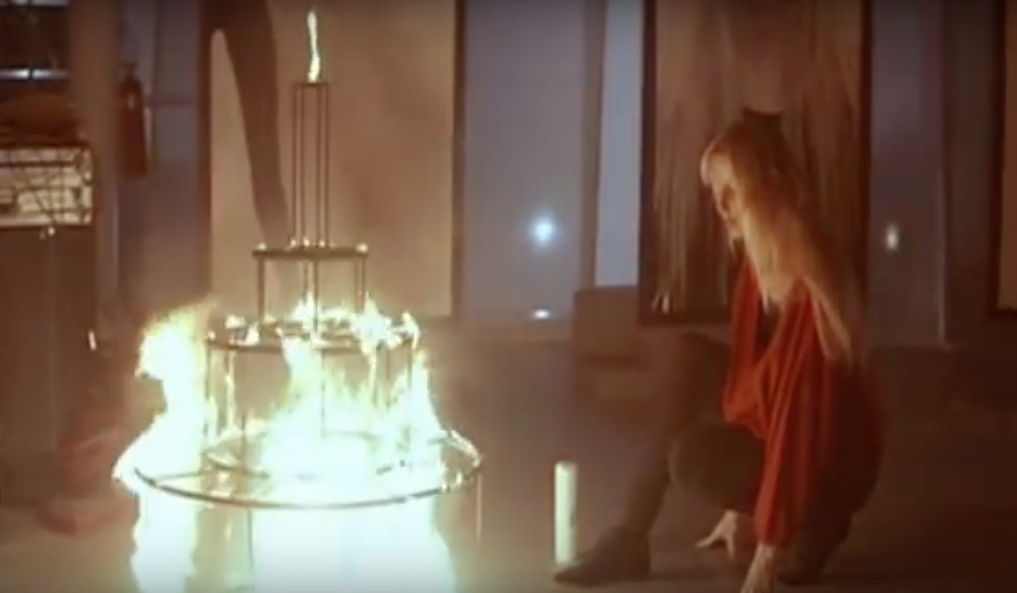
Darryl Hannah is a heavy-handed performance artist in Legal Eagles (1986). Courtesy of Universal Pictures.
Normal people, beware the art world! That’s the resounding takeaway of this 1986 romantic thriller starring Daryl Hannah and Robert Redford. Brimming with art-world stereotypes, the plot centers on Chelsea Deardon (Hannah), a dysfunctional performance artist traumatized by the suspicious death of her father, the celebrated artist Sebastian Deardon— in a fire which she (a child at the time) was saved from. Now grown, Deardon is arrested during an ill-fated attempt to recover a painting her father had dedicated to her, and winds up in the counsel of lawyers Laura Kelly (Debra Winger) and Tom Logan (Redford).
Oh, and about that fire: it destroyed all of Sebastain’s other works… supposedly. Want to venture a guess as to the mastermind behind the blaze? That’s right, an insurance-hungry art dealer by the name of Victor Taft (Terrance Stamp), who—in addition to being a murderous arsonist—is also the proprietor of 57th street gallery. Just one problem: he didn’t really destroy the work, although he did kill the artist (perhaps to corner the market?). A convoluted set of altercations play out, including an attempted bombing, fake identities, love triangles, fire-themed performance art, and Chelsea’s prized painting winding up hidden in a sculpture.
What’s the art like?: The elder Deardon’s work is never shown, but given the number of faux Jean Dubuffets and Picassos in the movie, we’d guess it’s something in between. The younger Deardon’s work is like terrible Chris Burden, but with flames.
Most memorable line: Laura Kelly: “She’s a performance artist. Happenings, very ephemeral experience.” Tom Logan: “She’s a what?”
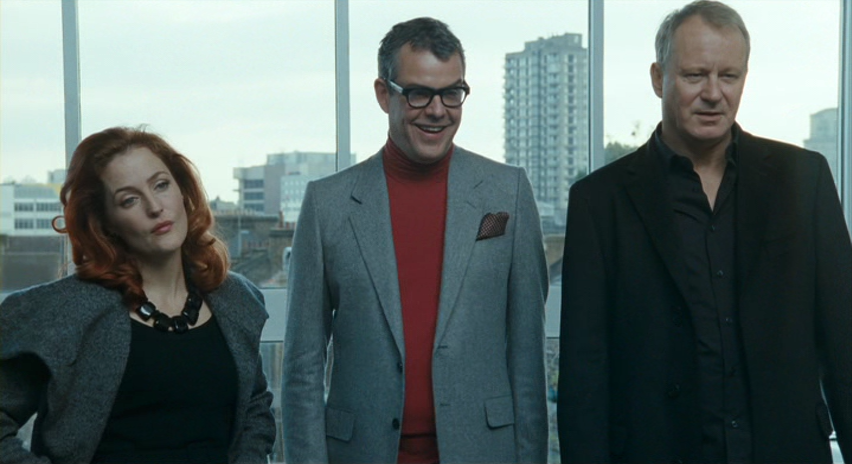
Art Spindle (center) is a paranoid art dealer willing—at any cost—to win in this nasty but vapid film about the art world. Courtesy of Vertigo Films.
This late-aughts satire is a snide wink at the supposed heartless depravity of the London contemporary art scene. In the star-studded film, artists (Amanda Seyfried), dealers, collectors (Gillian Anderson), and curators (Alan Cumming) compete with each other for success in an amoral, gossip-fueled art world hellscape that gets tired pretty fast. The cut-throat art dealer Art Spindle (Danny Huston) (and yes, the name is ridiculous) vies mercilessly with other art-world cognoscenti to try to sweet talk an aged collector (Christopher Lee) into selling his prized Mondrian painting, Boogie Woogie, which Spindle believes is valued at upwards of $20 million.
What’s the art like?: Boogie-Woogie is presumably meant to be Broadway Boogie-Woogie, Piet Mondrian’s 1943 homage to New York City.
Most memorable line: “Dad, this is art!”
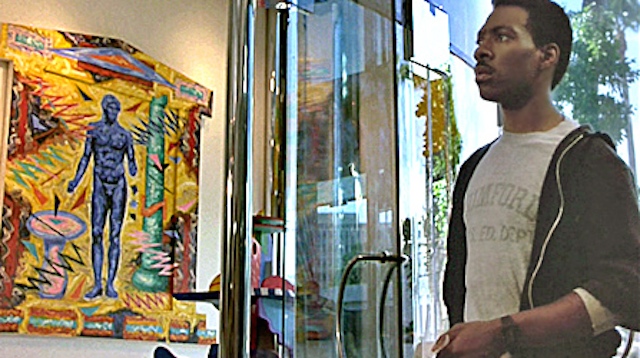
Eddie Murphy goes undercover gallery-hopping in Beverly Hills Cop (1984). Courtesy of Paramount Pictures.
Eddie Murphy stars as Axel Foley, a rough-around-the-edges Detroit cop who heads to Beverly Hills on a mission to solve the murder of his rag-tag friend Mikey Tandino (James Russo), bringing him right into the eye of a conspiratorial art-world storm. The movie opens with Tandino, a security guard at a Beverly Hills gallery, unexpectedly appearing at Foley’s apartment with some suspicious German bank bonds in hand. After a night out carousing and catching up, the pair return to the apartment where they’re jumped: Foley knocked out and Tandino murdered.
Taking a “vacation,” Foley travels to the West Coast where he forms an unlikely three musketeers with two Beverly Hills detectives. During his investigations, he uncovers the suspicious dealings of gallery owner Victor Maitland—that’s right, another evil art dealer named Victor. Maitland, it turns out, is a dealer of more than artworks. A shootout ensues at the factory where Maitland runs his drug ring (a must in any cop movie) and after many a tussle, Maitland is fatally wounded.
What’s the art like?: A gallery full of creepy mannequins seated at a dinner table.
Most memorable line: “You work here with Serge, in an art gallery. You’re not a cop.”
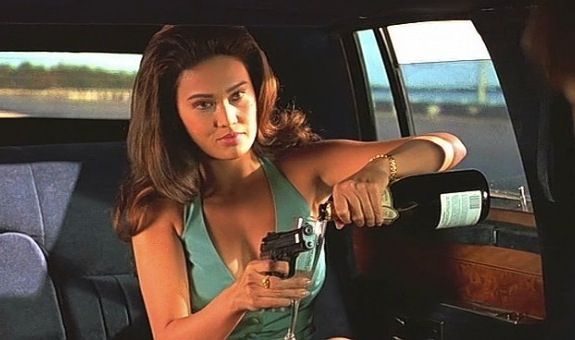
As an antiquities-dealer-turned-terrorist-accomplice, Juno Skinner has perfected the art of pouring champagne while multi-tasking. Courtesy of 20th Century Fox.
Of course, any ‘90s action thriller starring Arnold Schwarzenegger has got to include some variety of covert international intrigue… but a dealer of ancient art in cahoots with a terrorist cell? Sure, why not! While the comedic forays between undercover spy Harry Tasker (Schwarzenegger) and his unwitting but adventure-seeking wife (Jamie Lee Curtis) are the heart of this thoroughly entertaining flick, the art lovers among us will appreciate that central to the plot is Juno Skinner (Tia Carrere), a bad-seed antiquities dealer who collaborates with Crimson Jihad, the terrorist organization Tasker is charged with dismantling. In one scene, Schwarzenegger poses as a corporate art advisor, which is totally not suspicious at all.
What’s the art like?: Objects of the ancient world: lamassu, stele, and the like.
Most memorable line: “Those wimps [archaeologists]. It’s because I use my diplomatic contacts to export cultural treasures from countries which tell them to take a hike.”
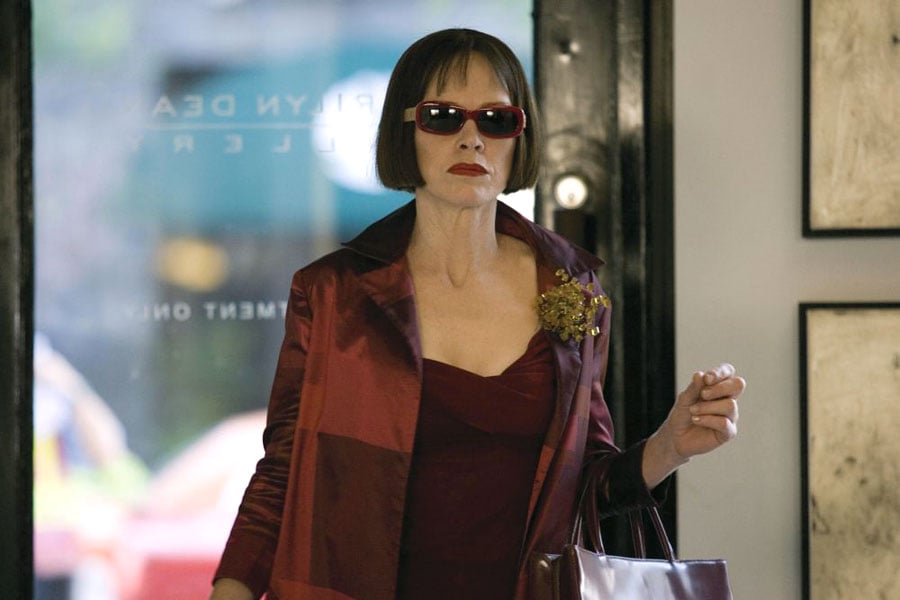
Marilyn Dean is the quintessential difficult gallerist in The Break-Up. Courtesy of Universal Pictures.
While this rom-com centers on the antics of Gary Grobowski (Vince Vaughn) and Brooke Meyers (Jennifer Aniston), a couple who continue to live as roommates after they break up, for some of us, it’s really about Brooke’s job as a gallery manager. At the pretend Chicago gallery, Aniston’s character bends over backwards to please the whims of the blunt-bob-wearing gallery owner, Marilyn Dean (Judy Davis), an artist herself, who hurls off insults and demands in the same breath. Among a list of art dealers who are murderers and arsonists, Dean may not seem quite a villain, but with her abusive/perfectionist behavior, she is certainly the most insidiously malevolent.
What’s the art like?: Chock-a-block with bland black-and-white abstractions.
Most memorable line: “Honey, this isn’t serialism or Cubism. It’s paint by numbers.”